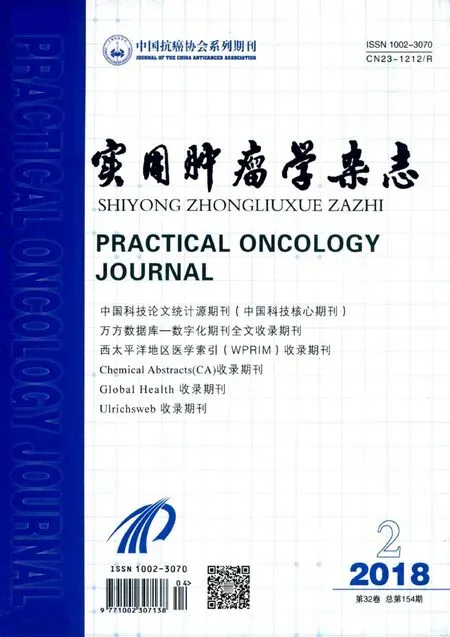硫氧还蛋白还原酶2在恶性肿瘤中的研究进展
吴逸飞 综述 刘宝刚 审校
硫氧还蛋白还原酶(TrxR)是一类二聚体硒蛋白,在生物体内起着抗氧化防御作用和参与细胞氧化还原状态的调节[1-2]。在真核生物体中,TrxR共有三种同工酶,TrxR1主要分布于细胞质,TrxR2主要分布于线粒体,TrxR3主要分布在睾丸组织中。通过对线粒体中分布的TrxR2的生物学功能的研究,推测它可能保护细胞避免受线粒体介导的氧化应激引起的损伤影响,这一发现与Trx在线粒体中的独特存在形式有关[3-6]。但是最近的基础研究发现,TrxR2在多种恶性肿瘤组织中表达上调,其表达情况远高于癌旁组织与正常组织,推测TrxR2可能为恶性肿瘤细胞中的原癌基因异常表达提供了庇护作用,从而减少凋亡并促进癌细胞增殖[7-8]。在TrxR2高表达的肿瘤组织中,HIF-1信号通路活化,VEGF表达上调,推测TrxR2与肿瘤血管内皮细胞的形成及肿瘤细胞的迁移密切相关[9]。另外,TrxR2的过表达使得肿瘤细胞对生长因子的敏感性增加,也增加了肿瘤细胞耐药的可能,现认为TrxR2的过度表达与癌症预后不良和治疗抵抗相关,因此抑制TrxR2的活性可能是治疗癌症的新策略[10]。本文旨在对TrxR2在几种恶性肿瘤中的研究进展进行综述,据此探究TrxR2能否成为恶性肿瘤的生物学标志物,并作为肿瘤治疗的新靶点。
1 TrxR2在恶性肿瘤中作用
过氧化物及自由基可以造成内源性的细胞损伤,一旦超过了内源性细胞的抗氧化能力,就会产生“氧化应激”效应,导致脂质过氧化和DNA损伤,过量活性氧簇(ROS)又可以通过释放细胞色素C来触发细胞凋亡。当细胞发生氧化应激损伤时,硫氧还蛋白系统活化对抗细胞质或线粒体中的自由基,并且调节细胞核中的下游基因的转录因子,从而使得细胞免受氧化应激损伤,避免了正常细胞的恶性增殖。但是,Lincoln等报道TrxR在具有高增殖能力、低细胞凋亡率和易发生转移的肿瘤中表达上调,如乳腺癌、甲状腺癌、前列腺癌和消化道恶性肿瘤[11]。Ylermi等报道Trx和TrxR也在肺癌中高度表达[12]。也有研究发现在肝细胞癌组织中TrxR2表达上调,推测可能参与肝细胞癌的发生发展[13]。另外,Hellfritsch等[9]研究TrxR2在恶性肿瘤中的作用机制时发现,抑制线粒体中的TrxR2活性,会影响到HIF-1信号通路,VEGF表达下调,最后肿瘤细胞血管内皮生成受到干扰,增殖受到抑制。铂类化合物、金制剂、姜黄素等[14-18]细胞毒药物能够抑制TrxR的活性,从而抑制癌细胞的抗氧化能力,诱导肿瘤细胞凋亡。其中,TrxR2过量表达的肿瘤组织,在姜黄素存在下出现了更高的ROS积累,同时也降低了抗肿瘤药的耐药性[19]。上述研究均提示TrxR2在恶性肿瘤组织中高表达可能促进肿瘤细胞的发生发展,并与抗肿瘤药物的耐药密切相关。
2 TrxR2与恶性肿瘤
2.1 TrxR2与非小细胞肺癌(NSCLC)
最近的研究发现,TrxR2在NSCLC肿瘤组织中表达上调,且在小于60岁的患者、发生淋巴结转移的患者、预后较差的患者中表现的更加明显。杨拴盈等[10]通过免疫组化法研究90例术后的NSCLC患者,其中56例患者存在淋巴结转移,TrxR2表达上调者占66.1%(37/56),34例无淋巴结转移患者中TrxR2表达上调者占41.2%(14/34),分析得出TrxR2的高表达可能与NSCLC淋巴结转移相关。同时,分别对这些患者进行18个月的随访,其中TrxR2高表达的患者总生存率为64.7%(33/51),TrxR2表达下调的患者总生存率为71.8%(28/39),分析得出TrxR2高表达的患者预后较差。但是,由于样本量小,随访时间短,且TrxR1在恶性胸膜间皮瘤中的表达情况与预后未表现出相关性,所以TrxR2能否指导预后还需深入研究。
NSCLC的发生要经历一个漫长和复杂的进程,针对其中涉及到的遗传和表观遗传的变化,探索NSCLC更有效的治疗策略至关重要[20]。目前对NSCLC病因的研究发现,氧化应激与其发病机制有关[21]。由于肿瘤细胞在氧化应激状态下增殖,所以会过度依赖于硫氧还蛋白系统来抵抗这种氧化应激损伤。TrxR2在包括NSCLC在内的多种癌症中表达上调[22-23],并且通过活化HIF-1α促进血管形成,还参与了肿瘤进展[5],抗细胞凋亡和保持应激失调的肿瘤细胞信号通路的传导[24-25]。传统的细胞毒药物抗肿瘤原理主要是基于氧化应激机制,TrxR2的过表达也增加了抗肿瘤药物的耐药可能,因此应用TrxR2的抑制剂治疗NSCLC可能是一种新策略[9-10]。Jayakumar等[18]研究发现应用姜黄素抑制TrxR2的活性不但可以抑制NSCLC细胞增殖,而且还能够诱导G1/S期细胞凋亡以及诱导细胞周期停滞。在检查姜黄素治疗后线粒体DNA损伤程度时发现每10 kb DNA就会出现5个碱基对断裂,而没有观察到细胞核DNA的损伤。因此,姜黄素可能是一种有效的抗肿瘤药物,也可能作为佐剂与传统的化疗药物一起治疗过度表达TrxR2的NSCLC。体外实验也证实了通过抑制TrxR2的活性,可以抑制NSCLC细胞的侵袭和迁移,并诱导细胞凋亡[10]。因此,TrxR2在NSCLC的发生发展中起到一定的生物学作用,可能是NSCLC治疗的潜在靶标。
2.2 TrxR2与肝细胞癌
TrxR-Trx-Prx系统可能通过调控细胞氧化还原状态,在细胞生长和转化过程中发挥重要作用,既往的研究发现Trx Ⅰ在肝细胞癌组织中表达明显升高[26],且Trx Ⅰ的高表达与铂类化合物的敏感性下降有关[27]。硫氧还蛋白Ⅱ(Trx Ⅱ)、TrxR2和过氧氧化还原酶Ⅲ(Prx Ⅲ)广泛分布于肝细胞线粒体中,在调节线粒体氧化还原状态中起关键作用,尤其是能够对抗H2O2产生的氧化损伤起到防御作用。为了研究ThxR2和Prx Ⅲ的表达情况与肝细胞癌关系,一项基础试验[13]通过免疫组织化学方法研究了58例石蜡包埋的肝细胞癌组织中TrxR2和Prx Ⅲ的表达情况。TrxR2和Prx Ⅲ的标记指数在肿瘤组织中明显高于癌旁组织和正常组织。在58例病理标本中,肿瘤组织中的TrxR2表达水平高于癌旁组织和正常组织的共有39例(67.2%),TrxR2在肿瘤组织中低表达有11例标本(19.0%)。与癌旁组织和正常组织相比,肿瘤组织中的Prx Ⅲ表达上调的有23例(39.7%),表达下调的有18例(31.0%)。总体结果提示,TrxR2或Prx Ⅲ的表达上调可能与肝细胞癌的发生和进展相关。迄今为止,该研究的关系TrxR2在肝细胞癌组织中过表达还是首次报道。为明确TrxR2参与肝细胞癌调控的具体分子机制,还需扩大样本量,作更深入的临床研究。
2.3 TrxR2与前列腺癌
最近研究[28]发现miRNA在前列腺癌中过表达,其中miR-17-92簇编码6种miRNA(包括miR-17,miR-18a,miR-19a,miR-20a,miR-19b-1和miR-92),在多种类型的恶性肿瘤组织被发现扩增。有研究发现miR-17的配体miR-17*在前列腺癌细胞中转染后显著降低了抗氧化蛋白的表达水平,用这种抑制线粒体中重要的抗氧化酶,如锰超氧化物歧化酶(MnSOD)、谷胱甘肽过氧化物酶-2(GPX2)和TrxR2的方法,可以间接的抑制前列腺癌的发生发展。研究肿瘤细胞供能机制时发现,肿瘤细胞有氧糖酵解呈高比例出现,这说明依靠线粒体有氧糖酵解也是肿瘤细胞增殖所需的供能方式[29],快速增殖的肿瘤细胞的高代谢也会造成线粒体中蓄积大量的ROS,同样线粒体也需要活化抗氧化防御系统来应对高水平的ROS[30-31]。这些抗氧化酶是线粒体中抗氧化系统的主要组成部分,它们相互协同来去除线粒体中产生的ROS。而miR-17*是位于线粒体中的三种重要抗氧化酶的负性调节因子,能够下调这些抗氧化酶的表达,导致ROS的积累,增加肿瘤细胞毒性,使肿瘤细胞死亡。由此可见,对抗氧化系统的选择性抑制可能成为干预肿瘤进展的一个重要策略。
2.4 TrxR2与宫颈癌
高危人乳头瘤病毒(Human papilloma virus,HPV)虽然被认为是宫颈癌的主要发病因素,但并不足以诱导肿瘤的发展。氧化应激被认为是HPV引发的致癌作用的促进因素之一。De Marco等[32]为了深入了解活性氧簇在宫颈癌中的作用,从浸润性鳞状细胞癌患者,高度不典型增生伴HPV感染的患者中收集HPV-16阳性病理组织,以无HPV感染的病理组织作对照,通过对氧化还原蛋白质组学分析探究氧化应激如何协助HPV驱动的病毒致癌。ERp57和GST在异型增生和肿瘤组织中急剧升高,TrxR2在异型增生组织中达到峰值,而异型增生和肿瘤组织中iNOS显著减少。且在肿瘤组织中,发现鳞状细胞癌抗原1、ERp57和GAPDH的氧化程度低于异型增生的组织。HPV16的致癌作用似乎与活性氧簇的增加有关。TrxR2在异常增生组织中,参与细胞形态和终末分化的DNA和蛋白质的氧化修饰,可能为肿瘤演变提供条件。相反,肿瘤组织似乎对氧化损伤获得了改善。TrxR2是维持细胞内环境重要的抗氧化酶。除了在肿瘤生物学的许多方面发挥重要意义外[33],其在蛋白质氧化损伤修复中的特定作用也表明TrxR2可能在细胞异型增生向恶性转化方面发挥作用[34]。
2.5 TrxR2与其他恶性肿瘤
据研究[35]发现Trx及TrxR与乳腺癌的预后相关,Trx及TrxR表达程度越高的患者,预后越差。但是,具体是TrxR的哪种同工酶与乳腺癌的发展及预后关系更为密切,还需进一步深入研究。另外,血液系统恶性肿瘤,如Burkitt淋巴瘤、CML的发生可能与位于22q11.2区的TrxR2相关[36],但仍需进一步研究。
3 小结与展望
TrxR2在几种恶性肿瘤中的表达情况已有深入研究,TrxR2可能成为以上几种恶性肿瘤治疗的潜在靶点,对TrxR2的抑制可能达到抑制恶性肿瘤细胞增殖、侵袭和迁移,并诱导恶性肿瘤细胞凋亡的效果。但是,TrxR2在其他恶性肿瘤中会发挥同样的作用吗?处于不同阶段的恶性肿瘤如何调控TrxR2的表达水平?这些还需要在更广泛人群(包括不同种类的恶性肿瘤,不同的病理亚型、疾病的不同阶段)中更深入研究。
1 Dagnell M,Pace PE,Cheng Q,et al.Thioredoxin reductase 1 and NADPH directly protect protein tyrosine phosphatase 1B from inactivation during H2O2exposure[J].J Biol Chem,2017,292(35):14371-14380.
2 Da Q,Wang P,Wang M,et al.Thioredoxin and NADPH-dependent thioredoxin reductase C regulation of Tetrapyrrole Biosynthesis[J].Plant Physiol,2017,175(2):652-666.
3 Radenkovic F,Holland O,Vanderlelie JJ,et al.Selective inhibition of endogenous antioxidants with Auranofin causes mitochondrial oxidative stress which can be countered by selenium supplementation[J].Biochem Pharmacol,2017,146(2):42-52.
4 Yan J,Xu J,Fei Y,et al.TrxR2 deficiencies promote chondrogenic differentiation and induce apoptosis of chondrocytes through mitochondrial reactive oxygen species[J].Exp Cell Res,2016,344(1):67-75.
5 Li H,Xu C,Li Q,et al.Thioredoxin 2 offers protection against mitochondrial oxidative stress in H9c2 cells and against myocardial hypertrophy induced by hyperglycemia[J].Int J Mol Sci,2017,18(9):1-10.
6 Forred BJ,Daugaard DR,Titus BK,et al.Detoxification of mitochondrial oxidants and apoptotic signaling are facilitated by thioredoxin-2 and peroxiredoxin-3 during hyperoxic injury[J].PLoS One,2017,12(1):e0168777.
7 Fisher-Wellman KH,Mattox TA,Thayne K,et al.Novel role for thioredoxin reductase-2 in mitochondrial redox adaptations to obesogenic diet and exercise in heart and skeletal muscle[J].J Physiol,2013,591(14):3471-3486.
8 Prasad R,Chan LF,Hughes CR,et al.Thioredoxin reductase 2(TXNRD2)mutation associated with Familial Glucocorticoid Deficiency(FGD)[J].J Clin Endocrinol Metab,2014,99(8):1556-1563.
9 Hellfritsch J,Kirsch J,Schneider M,et al.Knockout of mitochondrial thioredoxin reductase stabilizes prolyl hydroxylase 2 and inhibits tumor growth and tumor-derived angiogenesis[J].Antioxid Redox Signal,2015,22(11):938-950.
10 Bu L,Li W,Ming Z,et al.Inhibition of TrxR2 suppressed NSCLC cell proliferation,metabolism and induced cell apoptosis through decreasing antioxidant activity[J].Life Sci,2017,178(1):35-41.
11 Chen W,Zou P,Zhao Z,et al.Selective killing of gastric cancer cells by a small molecule via targeting TrxR1 and ROS-mediated ER stress activation[J].Oncotarget,2016,7(13):16593-16609.
12 Fan C,Zheng W,Fu X,et al.Enhancement of auranofin-induced lung cancer cell apoptosis by selenocystine,a natural inhibitor of TrxR1 in vitro and in vivo[J].Cell Death Dis,2014,5(4):1-11.
13 Choi JH,Kim TN,Kim S,et al.Overexpression of mitochondrial thioredoxin reductase and peroxiredoxin III in hepatocellular carcinomas[J].Anticancer Res,2002,22(6):3331-3336.
14 Kitanovic I,Can S,Alborzinia H,et al.A deadly organometallic luminescent probe:anticancer activity of a Rel bisquinoline complex[J].Chemistry,2014,20(9):2496-2507.
15 Chen X,Zhou HJ,Huang Q,et al.Novel action and mechanism of auranofin in inhibition of vascular endothelial growth factor receptor-3-dependent lymph angiogenesis[J].Anticancer Agents Med Chem,2014,14(7):946-954.
16 Ng HL,Xiang M,Chew EH,et al.Design,synthesis,and biological evaluation of coupled bioactive scaffolds as potential anticancer agents for dual targeting of Dihydrofolate Reductase and Thioredoxin Reductase[J].J Med Chem,2017,60(5):1734-1745.
17 Garcia A,Machado RC,Grazul RM,et al.Novel antitumor adamantane-azole gold(I)complexes as potential inhibitors of thioredoxin reductase[J].J Biol Inorg Chem,2016,21(2):1-18.
18 Jayakumar S,Patwardhan RS,Pal D,et al.Mitochondrial targeted curcumin exhibits anticancer effects through disruption of mitochondrial redox and modulation of TrxR2 activity[J].Free Radic Biol Med,2017,113(2):530-538.
19 Zhang B,Zhang J,Peng S,et al.Thioredoxin reductase inhibitors:a patent review[J].Expert Opin Ther Pat,2017,27(5):547-556.
20 Cui T,Srivastava AK,Han C,et al.XPC inhibits NSCLC cell proliferation and migration by enhancing E-Cadherin expression[J].Oncotarget,2015,6(12):10060-10072.
21 Zheng X,Xu W,Sun R,et al.Synergism between thioredoxin reductase inhibitor ethaselen and sodium selenite in inhibiting proliferation and inducing death of human non-small cell lung cancer cells[J].Chem Biol Interact,2017,275(2):74-85.
22 Radenkovic F,Holland O,Vanderlelie JJ,et al.Selective inhibition of endogenous antioxidants with Auranofin causes mitochondrial oxidative stress which can be countered by selenium supplementation[J].Biochem Pharmacol,2017,146(2):42-52.
23 Yan J,Xu J,Fei Y,et al.TrxR2 deficiencies promote chondrogenic differentiation and induce apoptosis of chondrocytes through mitochondrial reactive oxygen species[J].Exp Cell Res,2016,344(1):67-75.
24 Powis G,Kirkpatrick DL.Thioredoxin signaling as a target for cancer therapy[J].Curr Opin Pharmacol,2007,7(4):392-397.
25 Fink EE,Mannava S,Bagati A,et al.Mitochondrial thioredoxin reductase regulates major cytotoxicity pathways of proteasome inhibitors in multiple myeloma cells[J].Leukemia,2016,30(1):104-111.
26 Jan YH,Heck DE,Dragomir AC,et al.Acetaminophen reactive intermediates target hepatic thioredoxin reductase[J].Chem Res Toxicol,2014,27(5):882-894.
27 Duan D,Zhang B,Yao J,et al.Gambogic acid induces apoptosis in hepatocellular carcinoma SMMC-7721 cells by targeting cytosolic thioredoxin reductase[J].Free Radic Biol Med,2014,69(4):15-25.
28 Zhou P,Ma L,Zhou J,et al.Effects of overexpression of miR-17-92 gene cluster on the biological characteristics of prostate cancer cells and its mechanism[J].Zhonghua Zhong Liu Za Zhi,2017,39(5):325-331.
29 Diebold L,Chandel NS.Mitochondrial ROS regulation of proliferating cells[J].Free Radic Biol Med,2016,100(2):86-93.
30 Mdps I,Begley U,Begley TJ,et al.Mitochondrial ROS control of cancer[J].Semin Cancer Biol,2017,47(2):57-66.
31 Zhang J,Li X,Han X,et al.Targeting the thioredoxin system for cancer therapy[J].Trends Pharmacol Sci,2017,38(9):794-808.
32 De Marco F,Bucaj E,Foppoli C,et al.Oxidative stress in HPV-driven viral carcinogenesis:redox proteomics analysis of HPV-16 dysplastic and neoplastic tissues[J].PLoS One,2012,7(3):e34366.
33 De MF.Oxidative stress and HPV carcinogenesis[J].Viruses,2013,5(2):708-731.
34 Bi W,Wang Y,Sun G,et al.Paclitaxel-resistant HeLa cells have up-regulated levels of reactive oxygen species and increased expression of taxol resistance gene 1[J].Pak J Pharm Sci,2014,27(4):871-878.
35 Park SJ,Kim HB,Piao C,et al.p53R2 regulates thioredoxinreductase activity through interaction with TrxR2[J].Biochem Biophys Res Commun,2017,482(4):706-712.
36 Patwardhan RS,Pal D,Checker R,et al.Baicalein induces cell death in murine T cell lymphoma via inhibition of thioredoxin system[J].Int J Biochem Cell Biol,2017,91(1):45-52.

